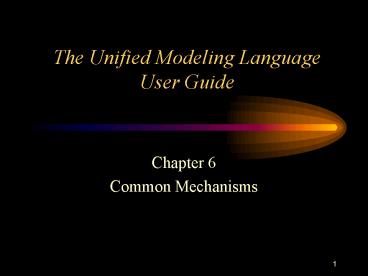The Unified Modeling Language User Guide - PowerPoint PPT Presentation
1 / 12
Title:
The Unified Modeling Language User Guide
Description:
Placed below the name of the UML element who's properties are being extended. ... Only use tagged values when UML does not already provide a mechanism to ... – PowerPoint PPT presentation
Number of Views:128
Avg rating:3.0/5.0
Title: The Unified Modeling Language User Guide
1
The Unified Modeling Language User Guide
- Chapter 6
- Common Mechanisms
2
Chapter 6 Topics
- Overview
- Terms and concepts
- Common modeling techniques
3
Overview
- All languages evolve over time. UML is no
different. - UML is an extensible language. It allows
developers to add features that are not a core
part of the language. - Added meaning is attached to existing UML
artifacts by the use of notes, stereotypes,
tagged values and constraints.
4
Terms and Concepts
- A note is
- A means by which comments may be attached to a
UML element (artifact). - A note is itself an artifact.
- Graphically represented by a rectangle with a
dog-eared corner, together with textual or
graphical content. - Attached to the artifact that is being clarified
with a dashed line. - Necessary because some information cannot be
communicated exclusively with pictures.
5
Terms and Concepts
6
Terms and Concepts
- An stereotype is
- A metatype, because it is used to create the
equivalent of a new type in UML. - A concise comment.
- In its simplest form enclosed in guillemets (ltlt
gtgt). - In its more complex form an icon.
- Attach the stereotype to whichever predefined UML
artifact is closest to the new type you are
attempting to model.
7
Terms and Concepts
- An tagged value is
- An extension of the properties of a UML element.
- Represented as a string enclosed in braces.
- The string is in the form name value.
- Placed below the name of the UML element whos
properties are being extended. - Commonly used in configuration management. For
example - programmer John Johnson
- version 4.56
- Not one of the more commonly used features of UML.
8
Terms and Concepts
9
Terms and Concepts
- A constraint is
- An extension of the meaning of a UML element.
- A means of adding new rules to existing ones.
- An indication of condition(s) that must be true
in order for the model to work. - Represented as a string encloses in braces and
placed near the associated element. - Alternatively represented as a note.
10
Terms and Concepts
11
Common Modeling Techniques
- Modeling comments
- If a comment is lengthy, put the comment in an
external document and then refer to the document
in a note. - Think of a note as a digital sticky note.
- Modeling stereotypes
- Only use stereotypes when UML does not already
provide a mechanism to communicate the desired
information. - Use short meaningful names for your stereotypes.
12
Common Modeling Techniques
- Modeling tagged values
- Only use tagged values when UML does not already
provide a mechanism to communicate the desired
information. - Tagged values defined for one kind of element
apply to all of its children. - Modeling constraints
- Only use constraints when UML does not already
provide a mechanism to communicate the desired
information. - Use short, meaningful descriptions for
constraints.































